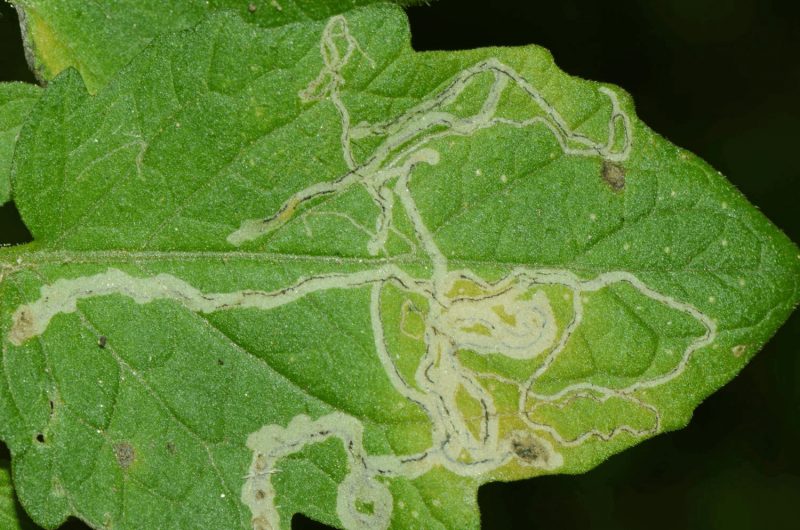American serpentine leafminer – pest management

The American serpentine leafminer (Liriomyza trifolii) is native to North America. It is a specific pest of greenhouses and polytunnels. It occurs frequently in tomato and eggplant crops.
Description. The adult is a small fly, 1.3-2.3 mm long, gray-black. The female is larger than the male. The fly has a yellow scutellum and ventral hairs. The eggs are very small, gray in color. The larva doesn’t have any legs, it is about 3 mm long, at first is transparent, then yellow-orange.
Life cycle. The American serpentine leafminer becomes active when temperatures are positive and continue to multiply until autumn. This pest produces 6-8 generations per year, in optimum environmental conditions, and it overwinters as a pupa in the surface layer of the soil. The adults are active in the morning and after 24 hours from their emergence, they start copulating and laying eggs. The female perforates the leaf to feed or lay eggs, reaching up to 600 eggs in 15-30 days of life. After hatching, the larvae feed on the leaf tissue.
Usually, in the greenhouses, there is an overlap of generations, and individuals of all ages can be found. The full development of a generation takes 15-20 days.
Crop damage. The American serpentine leafminers attack over 22 species of plants and are known to be the main pests of tomatoes and chrysanthemums in protected crops. They also cause damage to celery, onions, cucumbers, eggplants, peppers, lettuce crops, etc.
The larvae are the ones that cause the most significant damage, feeding on the leaf tissue, forming serpentine galleries between the epidermis of the leaf. When the length of these galleries exceeds 50% of the leaf surface, it dries and falls. Adults make holes in the leaves for feeding, creating gateways for bacteria and fungi. Through their way of feeding, adults are also transmitters of viruses.
The main source of infestation with this pest is represented by procuring affected seedlings from greenhouses, especially since the plants’ infestation starts from the seedling phase.
Pest management. The thorough control of the planting material before planting the culture and even after that contributes to the limitation of the pest populations. Low temperatures do not help the insect to develop.
It is recommended to gather the vegetable remains left in the greenhouses after the harvest of the culture and burn them. Also, in the protected areas, curative treatments have to be applied before transplanting the seedlings to destroy the sources of infestation.
The treatments have to be performed with specific insecticides.
Recommended products
-
You can find products on a different store
Change Store -
You can find products on a different store
Change Store -
You can find products on a different store
Change Store -
You can find products on a different store
Change Store -
You can find products on a different store
Change Store -
You can find products on a different store
Change Store -
You can find products on a different store
Change Store -
You can find products on a different store
Change Store -
You can find products on a different store
Change Store -
You can find products on a different store
Change Store -
You can find products on a different store
Change Store -
You can find products on a different store
Change Store -
You can find products on a different store
Change Store -
You can find products on a different store
Change Store -
You can find products on a different store
Change Store -
You can find products on a different store
Change Store -
You can find products on a different store
Change Store -
You can find products on a different store
Change Store -
You can find products on a different store
Change Store -
You can find products on a different store
Change Store -
You can find products on a different store
Change Store -
You can find products on a different store
Change Store -
You can find products on a different store
Change Store -
You can find products on a different store
Change Store

















































































































































































































































































































































































































































